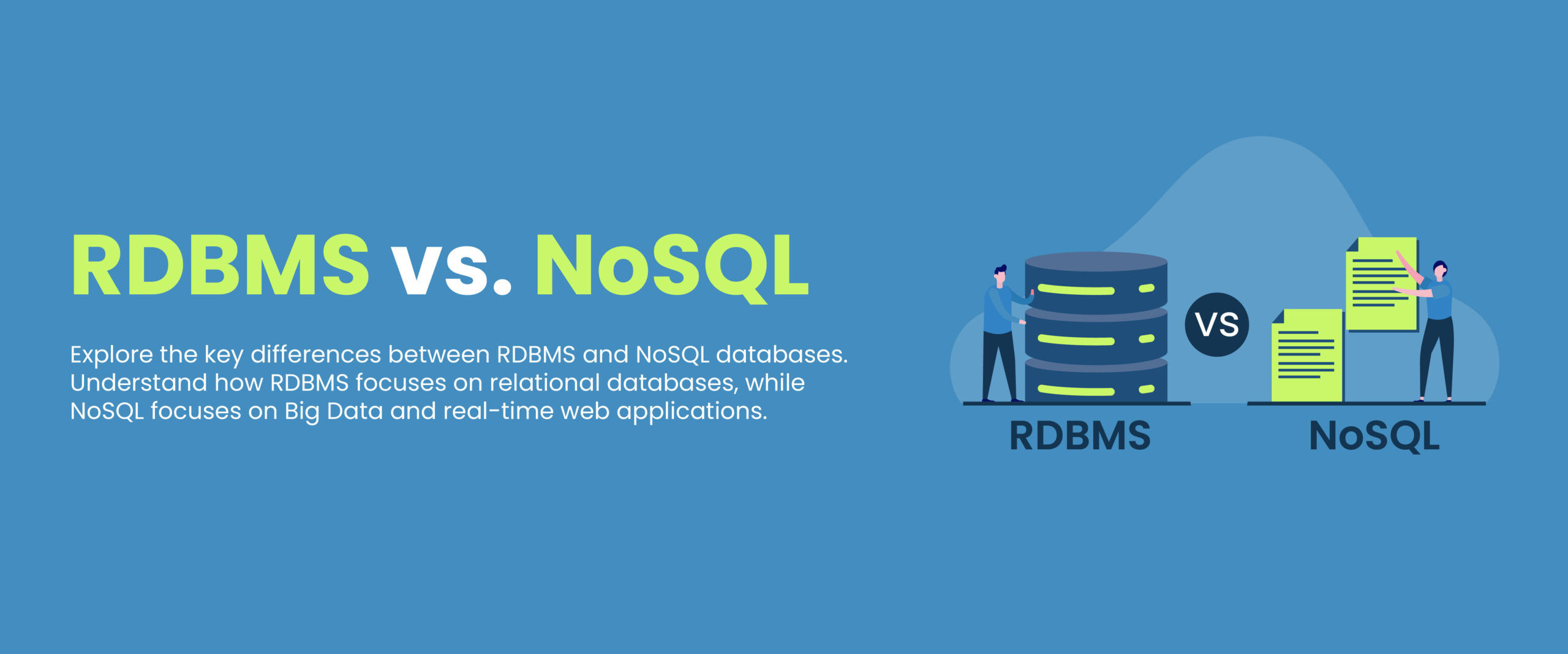RDBMS vs NoSQL- Which is Better?
In the digital age, data management has become the backbone of modern applications. Did you know that over 80% of global businesses use some form of NoSQL technology? As organizations and businesses grapple with vast amounts of data, the choice between Relational Database Management Systems (RDBMS) and NoSQL databases has become critical. In this blog, we will take a look at RDBMS vs. NoSQL and understand their unique attributes and use cases.
RDBMS and No SQL Overview
A Relational Database Management System (RDBMS) is a type of database system that stores information in the form of related tables. It uses Structured Query Language (SQL) to store and manipulate data, as well as to define an organization’s data structure. RDBMSs are widely used for enterprise applications such as customer relationship management systems, financial databases, or even airline reservation systems.
No SQL on the other hand, is a non-relational database system designed primarily
for large-scale distributed data storage. Unlike RDBMSs, which use relational models and SQL queries to access data, NoSQL employs non-relational models such as key/value pairs, document stores, graph databases, and columnar databases. To learn more about RDBMS vs. NoSQL, you can pursue a full-fledged SQL course.
Difference Between RDBMS and NoSQL
Let’s have a look at the difference between RDBMS and NoSQL.
| RDBMS | NoSQL |
| It was developed in the 1970s. | It was developed in the 2000s. |
| The primary reason for development was to deal with flat file storage. | The primary reason for development was to overcome the shortcomings of the SQL database. |
| RDBMS stores data in a structured manner in the form of a table. | NoSQL stores data in an unstructured manner because it is a non-relational database system. |
| RDBMS are harder to construct as they follow ACID properties. | NoSQL may or may not support ACID to store data. |
| The RDBMS supports multiple users. | NoSQL also supports multiple users. |
| RDBMS stores data in the form of tables. | NoSQL stores data in structured, semi-structured, and unstructured forms. |
| It supports the normalization concept and the joining of tables. | It does not support normalization. |
| It is an open-source application. | It is an open-source program. |
| The RDBMS supports integrity constraints. | NoSQL does not support integrity constraints, |
| It deals with large sets of data. | It was mainly developed to handle big data and real-time web data. |
| RDBMS supports a client-server architecture. | NoSQL supports a multi-server architecture, including a client-server architecture. |
| Data are related to each other with the help of foreign keys. | In NoSQL, data can be stored in a single file. |
| Data fetching is rapid. | Data fetching is easy. |
| A relational database is used to handle data coming at low velocity. | A NoSQL Database is used to handle data coming at high velocity. |
| It has a fixed schema. | It has no fixed schema. |
| RDBMS have a single point of failure with failover. | NoSQL databases have no single point of failure. |
| RDMS supports complex transactions. | NoSQL supports only simple transactions. |
| In RDBMS, data mainly arrives from one location. | In NoSQL, data may arrive from multiple locations. |
| RDBMS gives only read scalability. | NoSQL gives both read and write scalability. |
| RDBMS is applied vertically. | NoSQL is applied horizontally. |
| Examples of RDBMS are Oracle, MySQL, SQL Server, etc. | Examples of NoSQL are IBM Domino, Apache HBase, Oracle NoSQL, etc. |
RDBMS Vs. NoSQL: Which One To Choose?
It is difficult to ascertain the correct choice without considering your needs; each has its advantages in facilitating the requirement.
Here are a few advantages of RDBMS and NoSQL to make the choice accordingly.
| Aspect | RDBMS | NoSQL |
| Maintainability | Schema-based structure makes it easier to enforce data consistency and integrity. A schema-based structure allows an RDBMS to enforce data consistency and integrity through defined relationships, constraints, and data types. | Schema-less or flexible schemas allow for easier adaptation to changing data requirements.NoSQL databases, being schema-less or having flexible schemas, can easily adapt to changing data requirements, making it simpler to add or modify data without strict constraints. |
| Data Structure | Tabular structure with rows and columns (relational tables). Relational databases organize data into tables with rows and columns, which work well for structured data with clear relationships between entities. | Non-relational, flexible data models like key-value pairs, documents, column-family, or graphs NoSQL databases employ various data models (key-value pairs, documents, columns, and graphs) to accommodate different data structures, making them suitable for semi-structured or unstructured data, or cases where the schema may change frequently. |
| Open Source | Many open-source RDBMS options are available (e.g., MySQL and PostgreSQL). | Several open-source NoSQL databases are available (e.g., MongoDB, Couchbase). |
| Data Model | Follows a fixed schema, making it ideal for structured data.Traditional relational databases follow a fixed schema, ideal for scenarios where the data model is well-defined and unlikely to change frequently. Suitable for highly structured data. | Supports dynamic or evolving data models, suitable for semi-structured or unstructured data. NoSQL databases support dynamic or evolving data models, making them well-suited for scenarios where the data structure is subject to change and for effectively handling semi-structured or unstructured data. |
Conclusion
The choice depends on the difference between RDBMS and NoSQL and on various factors such as the nature of the data, scalability requirements, data consistency needs, and the specific use case of the application. Each type of database has its strengths and weaknesses, and the decision should be based on a careful analysis of the project’s requirements and goals.







